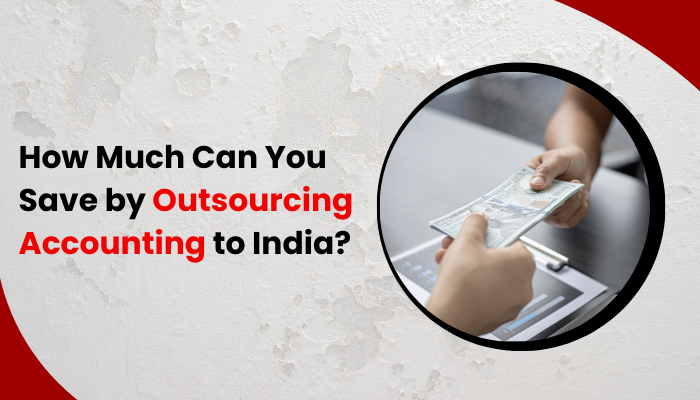If you’ve ever stared at your company’s monthly financial reports and thought, “We’re spending too much just to keep the books in order,” you’re not alone. Many small to mid-sized businesses feel the same. That’s where outsourcing accounting to a country like India comes into play—not just as a cost-cutting measure, but as a smart, scalable business strategy.
Over the last decade, India has earned a reputation as a global hub for professional accounting services, offering everything from bookkeeping and payroll to complex tax compliance. And yes—when done right—the savings can be significant. But how much can you really save by outsourcing accounting to India? Let’s break it down in real terms.
1. The Real Cost of In-House Accounting
Before calculating savings, you need to understand what in-house accounting is costing you—not just in salaries, but in hidden expenses.
Here’s what typically goes into having a full-time accounting department in the U.S.:
-
Annual salaries for accountants and bookkeepers: $50,000–$80,000 per employee
-
Payroll taxes and benefits: Health insurance, paid time off, retirement contributions
-
Software and tools: QuickBooks, Xero, payroll systems, tax filing software
-
Training and compliance costs: Keeping staff up to date with laws and best practices
-
Office space and equipment: Desks, computers, utilities
It’s not unusual for a small business to spend $70,000–$120,000 annually just to maintain basic accounting operations.
2. Why India Is a Top Choice for Outsourcing Accounting
So why are U.S. businesses choosing India over other countries for outsourcing accounting?
-
Lower labor costs: Skilled accountants in India typically earn 60–70% less than their U.S. counterparts.
-
English proficiency: Most Indian accounting professionals are fluent in English, making communication seamless.
-
Time zone advantage: India’s time difference means work can be done overnight and ready by your morning.
-
Highly qualified talent pool: Many accountants in India are trained in U.S. GAAP, IFRS, and international tax laws.
-
Technology integration: Indian firms are adept at working with cloud-based accounting software used globally.
When you combine these factors, outsourcing becomes more than just a way to save—it’s a way to enhance efficiency and quality.
3. Breaking Down the Savings
Let’s put numbers to the savings.
Example: U.S. In-House vs. Outsourcing Accounting to India
| Expense Category | U.S. In-House (Annual) | Outsourced to India (Annual) |
|---|---|---|
| Salary per Accountant | $65,000 | $18,000 |
| Benefits & Taxes | $12,000 | $0 |
| Software & Tools | $3,000 | Included in service |
| Office Space & Equipment | $4,000 | $0 |
| Training Costs | $1,500 | $0 |
| Total | $85,500 | $18,000–$20,000 |
Potential Savings: $65,000+ per year per accountant
Even after accounting for service provider fees, currency exchange, and possible onboarding costs, businesses often save 50–70%.
4. Services You Can Outsource
When we talk about outsourcing accounting, we’re not just talking about basic bookkeeping. Indian firms handle:
-
Accounts payable & receivable management
-
Payroll processing
-
Bank reconciliation
-
Tax preparation & filing (U.S. & international)
-
Financial statement preparation
-
Audit support
-
Compliance reporting
And the best part? Many providers offer customized service packages, so you only pay for what you actually need.
5. Quality vs. Cost: Is It Worth It?
Here’s the truth: Saving money is great, but not if it costs you accuracy and compliance. Fortunately, top Indian accounting firms have:
-
Certified accountants with CPA or ACCA credentials
-
Strict data security measures compliant with GDPR and U.S. privacy laws
-
Service level agreements (SLAs) that guarantee turnaround times and accuracy
-
Experience with multiple industries, from e-commerce to manufacturing
When you choose the right partner, you’re not trading quality for cost—you’re getting both.
6. Real-World Case Study
One U.S.-based e-commerce brand with $5M in annual revenue was spending $110,000 yearly on in-house accounting. After switching to outsourcing accounting to an Indian firm, they reduced costs to $38,000 annually.
Savings: $72,000 a year
Additional Benefits: Faster month-end closings, 24-hour support, and more detailed financial reporting.
The business reinvested those savings into marketing, which helped increase sales by 18% in the next quarter.
7. Key Considerations Before You Outsource
Before jumping in, think about:
-
Data security: Ensure your provider uses encryption and secure data transfer protocols.
-
Industry experience: Choose a provider with a track record in your business sector.
-
Scalability: Make sure they can handle increased workload as your business grows.
-
Communication: Set clear expectations for reporting, updates, and meetings.
8. Steps to Get Started
If you’re ready to explore outsourcing accounting to India, here’s a quick roadmap:
-
Identify your needs – Bookkeeping, payroll, tax prep, or full-service accounting?
-
Shortlist providers – Look for firms with verified testimonials and U.S. client experience.
-
Request proposals – Compare scope, pricing, and turnaround times.
-
Run a pilot project – Start small before committing long-term.
-
Sign an SLA – Ensure both sides agree on deadlines, deliverables, and data protection.
Final Thoughts
When done thoughtfully, outsourcing accounting to India can be one of the smartest financial decisions a business makes. You’re not just saving money—you’re freeing up time, gaining access to a global talent pool, and positioning your business for long-term growth.
For many companies, the savings—often 50–70% of current costs—are just the beginning. The real benefit is the efficiency, scalability, and expertise that comes with it.
If you’ve been on the fence, maybe it’s time to take the first step. Because when it comes to outsourcing accounting work to India, the question isn’t “Should you?”—it’s “Why haven’t you started yet?”
Click – techtrekspot.online
